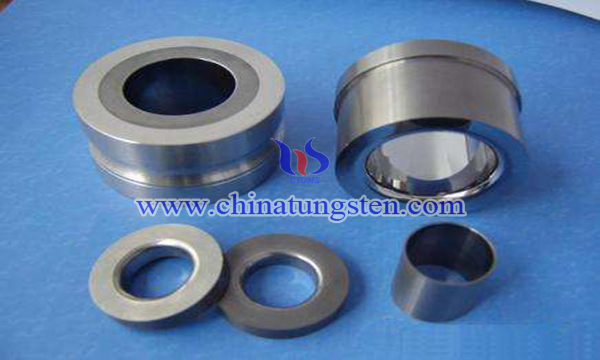Combined Tungsten Carbide Dies with Hot Headers
- Details
- Category: Tungsten Information
- Published on Sunday, 06 May 2018 19:42
For a long time, the production of fasteners is mainly processed by cold headers, punching or machine adding. Shapes of the part is complicated, and the forming difficulty is large, so the hot forming method is used. During processing, the molding die used is usually a hot piercing die, and the die is the whole form. Ejector rod usually adopts high speed steel material.
Because of the small structure size, the large deformation resistance of the parts and the high temperature of the thermoforming, the red rigidity of the high-speed steel top rod cannot meet the requirements, and it is easy to soften and fail. Therefore, the service life of the die, especially the punch or the top rod is too low, and it is difficult to form the parts, and the qualified rate is low, and the quality is difficult to guarantee.

Combined tungsten carbide dies with hot headers is mainly composed of a template, a punch or a top rod, a lower top rod, a fixed seat, an upper pad, a lower pad, a negative mold, a guide sleeve, a coat, a cushion block and a mold pad. Its characteristic is that the punch or top rod is a split structure. The working part of the hard alloy material is combined with the positioning support part made of medium carbon steel or alloy steel. The working part of the punch or top rod is filled with the positioning support part and welded in one piece. The two parts are effectively connected by welding, and some of the die materials are cemented carbide.
Compared with the existing technology, the advantages are as follows. 1, Because of the change of the overall structure of the punch or the top rod, the rigid alloy die with the hot piers has been used to improve the life of the die and improve the product quality, the qualified rate and the productivity.2, The structure is simple, the manufacture is convenient, and the cost is almost not increased.
- Tungsten Carbide Manufacturer & Supplier, Chinatungsten Online: tungsten-carbide.com.cn
- Tungsten News & Prices of China Tungsten Industry Association: www.ctia.com.cn
- Molybdenum News & Price: news.molybdenum.com.cn
- Tel.: 86 592 5129696; Fax: 86 592 5129797; Email: sales@chinatungsten.com



 sales@chinatungsten.com
sales@chinatungsten.com